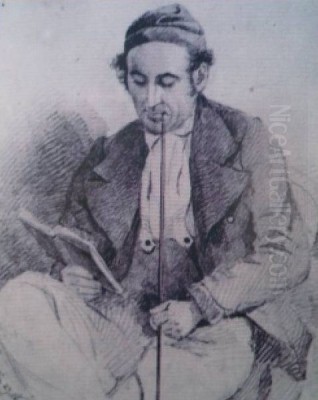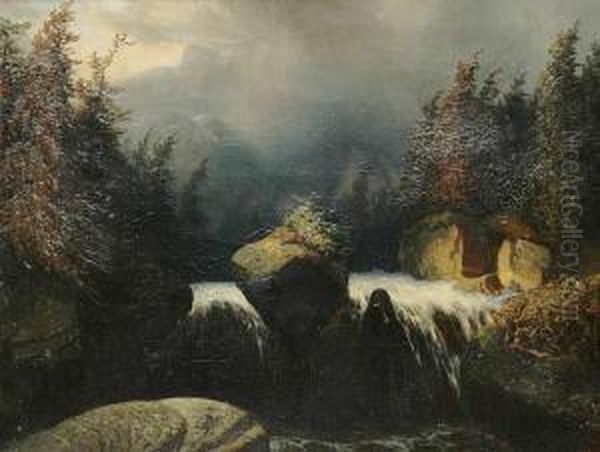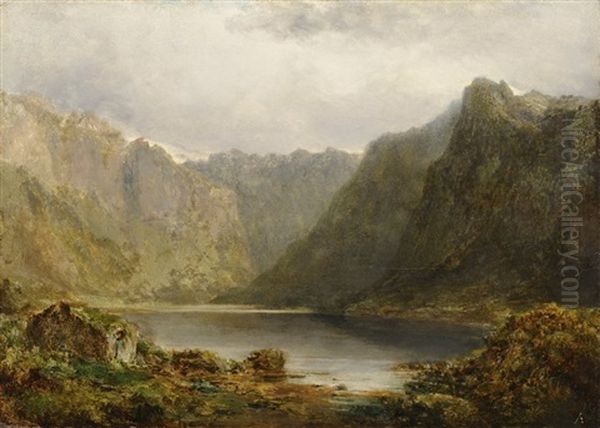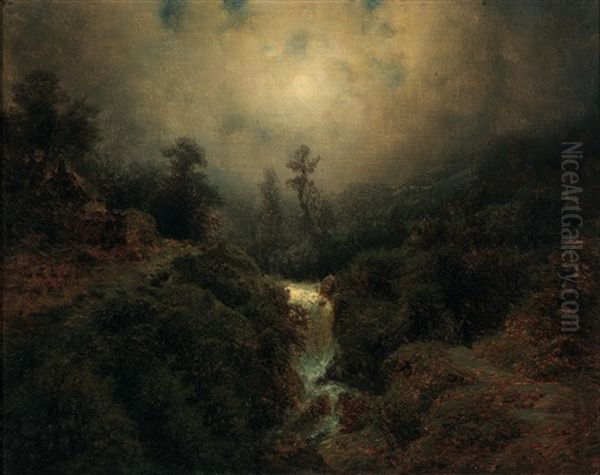
August Bedřich Piepenhagen stands as a significant figure in the landscape of 19th-century Central European art. A painter and printmaker primarily associated with the Czech lands, he navigated the transition from late Classicism to the burgeoning Romantic movement, carving out a distinct niche with his evocative and atmospheric depictions of nature. Though born in Prussia, his life and career became inextricably linked with Prague, where he developed his signature style and influenced a generation of artists, including his own daughters. His journey from a craftsman's apprentice to a respected landscape painter is a testament to his dedication and innate artistic sensibility.
Piepenhagen's work is characterized by its intimate scale, subtle emotional depth, and a profound connection to the natural world, often imbued with a sense of melancholy or quiet contemplation. He excelled in capturing the nuances of light and atmosphere, particularly in scenes of forests, mountains, and lakes, often under dramatic or transitional skies. While influenced by broader European Romantic trends, his art retained a personal, almost introspective quality that resonated with the Biedermeier sensibilities prevalent in the region. This article delves into the life, work, and legacy of this important, yet sometimes overlooked, master of Bohemian Romanticism.
Early Life and Artistic Awakening
August Bedřich Piepenhagen was born on August 2, 1791, in Soldin, Brandenburg, Prussia (now Myślibórz, Poland). His early life was not initially directed towards the arts. He began his working life apprenticed as a tailor and button-maker, a practical trade far removed from the painter's studio. However, a burgeoning interest in drawing and the visual world soon began to shape his path. A pivotal moment came during his journeyman years, which, as was customary, involved travel.

His travels took him through various parts of Europe, including a significant period spent in Switzerland around 1810-1811. It was here, amidst the dramatic Alpine scenery that would later feature prominently in his work, that his artistic inclinations truly solidified. In Zurich, he sought out formal instruction, however brief, from the landscape painter Johann Heinrich Wuest (1741–1821). Wuest, though perhaps not a major figure on the European stage, provided Piepenhagen with foundational skills and likely encouraged his focus on landscape. This formal training, combined with his own keen observation and relentless self-study, laid the groundwork for his future career.
After his time in Switzerland and further travels, Piepenhagen made the decisive move to settle in Prague around 1811 or shortly thereafter. Prague, the historic heart of Bohemia, possessed a growing artistic community and offered opportunities for a young artist seeking to establish himself. He initially continued working in crafts related to his earlier training, but painting increasingly became his primary focus. The city would remain his home and the center of his artistic activities for the rest of his life.
Prague: The Artist's Haven
Settling in Prague marked the true beginning of Piepenhagen's professional artistic life. The city, while perhaps not as dominant an art center as Vienna or Munich, had a rich cultural history and an active community of artists and patrons. Early 19th-century Prague saw a gradual flourishing of landscape painting, moving away from purely topographical views towards more atmospheric and emotionally resonant depictions. Figures like Karel Postl (1769–1818) had already begun to establish landscape as a serious genre within the Prague Academy of Fine Arts.
Piepenhagen, however, largely operated outside the formal structures of the Academy for much of his career. He was primarily self-taught beyond his initial instruction from Wuest, developing his style through personal study, observation of nature, and likely exposure to works by other artists, perhaps including Dutch 17th-century masters whose influence can sometimes be discerned in his handling of light and atmosphere. He quickly gained recognition for his talent and distinctive approach.
From the 1820s onwards, Piepenhagen dedicated himself almost exclusively to landscape painting and printmaking. He began participating in exhibitions, including those organized by the Prague Academy, bringing his work to public attention. His intimate, often moody landscapes found favor with the growing bourgeois collectors of the Biedermeier era, who appreciated their manageable scale and relatable sentiment. Prague provided not only a market but also a rich source of inspiration, with its surrounding forests and proximity to mountainous regions.
Mastering the Landscape: Style and Technique

Piepenhagen's artistic style is firmly rooted in Romanticism, but with a specific Central European inflection. Unlike the dramatic, often overwhelming sublimity found in the work of some German Romantics like Caspar David Friedrich, Piepenhagen's landscapes, while often depicting impressive natural scenes like the Alps, tend towards a more intimate and atmospheric interpretation. His focus was less on precise topographical accuracy and more on capturing the mood, the time of day, and the subtle interplay of light and shadow.
His technique in oil painting was characterized by delicate brushwork, often building up layers of thin glazes to achieve depth and luminosity. He possessed a remarkable sensitivity to atmospheric effects – mist rising from a valley, the soft glow of twilight, the crisp air of a winter morning. His color palettes were often subdued, favoring earthy tones, greens, blues, and grays, which contributed to the often melancholic or contemplative feeling of his work. He frequently depicted scenes featuring forests, lakes, mountain paths, ruins, and small figures dwarfed by the grandeur of nature, emphasizing themes of solitude and the human connection to the environment.
A fascinating aspect of his technique was his occasional experimentation with materials. There are accounts and evidence, for instance in works like Mountain Landscape, suggesting he sometimes mixed sand or other granular materials into his paint. This was likely done to alter the texture and affect the way light reflected off the surface, adding another layer of visual interest and enhancing the atmospheric quality he sought. This experimental spirit underscores his dedication to finding the most effective means to translate his vision onto the canvas.
Printmaking Prowess
Alongside his prolific output in oil painting, Piepenhagen was also a skilled printmaker, particularly adept in etching and lithography. His engagement with lithography began relatively early in the medium's development in Bohemia. Around 1821-1822, he became associated with the workshop established by the prominent Prague portraitist Antonín Machek (1775–1844). Machek was instrumental in promoting the new technique of lithography in Prague.
Piepenhagen quickly mastered the medium, using it not just for reproduction but as a primary means of artistic expression. A key early work is his lithograph Desolate Landscape (Pustá krajina), exhibited at the Prague Academy in 1822. This piece is considered a pioneering work in Czech graphic arts, showcasing his ability to translate the atmospheric qualities of his paintings into the tonal nuances achievable with lithography, particularly using the soft-ground technique which could mimic the texture of chalk or crayon drawings.

His prints often explored similar themes and motifs as his paintings – romantic landscapes, forest interiors, mountain vistas, and scenes with solitary figures or small cottages. Etching allowed him to utilize fine lines and cross-hatching to create detailed textures and dramatic contrasts of light and dark, while lithography offered softer tonal gradations well-suited to his atmospheric style. His graphic works were crucial in disseminating his artistic vision to a wider audience beyond those who could afford original paintings.
Key Works and Recurring Themes
While Piepenhagen produced a large body of work, several paintings and prints stand out as representative of his style and thematic concerns. His early lithograph, Desolate Landscape (1822), remains significant for its technical innovation and its early expression of Romantic sensibility in Czech printmaking. It captures a sense of solitude and the untamed aspect of nature.
Among his oil paintings, Mountain Landscape with Pilgrims (Horská krajina s poutníky), dated around 1826, exemplifies his approach to Alpine scenery. The towering mountains create a sense of awe, but the presence of small pilgrim figures introduces a human element and a narrative touch, suggesting themes of journey, faith, and humanity's place within the vastness of nature. The handling of light filtering through clouds or illuminating peaks is characteristic of his skill.
Works like Winter Village or numerous depictions of forest interiors showcase his ability to capture specific times of day and seasons. Winter landscapes were a recurring motif, allowing him to explore the stark beauty of snow-covered scenes, the subtle play of light on ice and snow, and the feeling of quiet stillness or harsh survival. Forest scenes often emphasize the verticality of trees, creating enclosed, almost sacred spaces, sometimes pierced by shafts of light.
His paintings often titled Landscape with Lake, Moonlit Landscape, or featuring ruins, further explore Romantic themes. Lakes provide reflective surfaces to capture changing skies, moonlight introduces mystery and heightened emotion, and ruins evoke the passage of time and the relationship between nature and human history. The recurring presence of small, often solitary figures – wanderers, shepherds, hermits – reinforces the sense of individual contemplation within the natural world, a hallmark of Romantic thought. The Oil Well series, such as Oil Well at Night and Oil Well below the Alps, adds an unusual, perhaps industrial or proto-industrial element, treated with the same atmospheric sensitivity.
A Circle of Influence: Contemporaries and Connections
August Bedřich Piepenhagen did not work in isolation. He was part of a vibrant artistic milieu in Prague and connected to broader European trends. His initial training came from the Swiss painter Johann Heinrich Wuest. In Prague, his association with Antonín Machek was significant, particularly in the realm of lithography. Machek, a leading portraitist, provided a crucial link to the technical advancements in printmaking.
Piepenhagen also maintained friendships with figures outside the visual arts who shared a Romantic sensibility. Most notably, he developed a close friendship with the Austrian writer, poet, and painter Adalbert Stifter (1805–1868). Stifter, known for his detailed descriptions of nature in his literary works and his own landscape paintings (often influenced by the Biedermeier style), frequently visited Piepenhagen's studio. Their shared appreciation for nature and landscape likely fostered mutual influence and intellectual exchange.
Within the Prague art scene, Piepenhagen was a contemporary of other notable artists. Antonín Mánes (1784–1843), a professor at the Academy and a key figure in Czech landscape painting, represented a slightly more classical or idealized approach initially, though he later embraced Romanticism. His nephew, Josef Mánes (1820–1871), became a leading figure of Czech Romanticism, moving towards national themes and realism, representing the generation following Piepenhagen but certainly aware of his work. Josef Navrátil (1798–1865), known for his decorative painting and genre scenes, was another prominent contemporary active in Prague.
Looking at the broader European context, Piepenhagen's work can be seen in dialogue with German Romanticism. While perhaps less overtly philosophical or symbolic than Caspar David Friedrich (1774–1840), there are shared interests in mood, atmosphere, and the spiritual dimension of nature. Carl Gustav Carus (1789–1869), a friend of Friedrich and a painter and theorist himself, explored similar landscape themes. In the German-speaking world, the popular Romantic style of Adrian Ludwig Richter (1803–1884) also provides context. For Alpine scenes, the work of Swiss painter Alexandre Calame (1810–1864) offers a point of comparison. Even Austrian painters like Ferdinand Georg Waldmüller (1793–1865), though often associated more with Biedermeier realism, were contemporaries exploring light and nature.
Piepenhagen's most direct artistic lineage, however, continued through his own family. His daughters, Charlotta Piepenhagen-Mohr (1821–1902) and Louisa Piepenhagen (1825–1893), both became accomplished landscape painters. They trained under their father and largely continued in his stylistic vein, ensuring the Piepenhagen approach to landscape painting extended into the later 19th century.
The Piepenhagen School and Legacy
Beyond his own artistic output, August Bedřich Piepenhagen contributed to the development of Czech art through teaching. He ran a successful private painting school in Prague, attracting numerous students eager to learn his approach to landscape painting. This school became an important alternative or supplement to the official training offered by the Prague Academy of Fine Arts. His teaching emphasized direct observation of nature combined with the techniques he had mastered for capturing atmosphere and mood.
His most notable students were undoubtedly his daughters, Charlotta and Louisa. They absorbed his style and themes, often working so closely in his manner that attributions can sometimes be challenging. Both achieved recognition in their own right, exhibiting their works and carrying forward the family's artistic reputation. Their success highlights Piepenhagen's effectiveness as a teacher and the appeal of his particular landscape vision.
Piepenhagen's influence extended beyond his immediate students. His consistent focus on landscape, his technical proficiency, and the emotional resonance of his work helped solidify landscape painting as a major genre in Bohemian art. He demonstrated that intimate, atmospheric landscapes could be as compelling as grand historical or mythological scenes. While later Czech landscape painters, such as the highly influential Julius Mařák (1832–1899) and his school at the Prague Academy, would develop different styles, often incorporating elements of Realism and Impressionism, Piepenhagen's work remained a significant precedent within the Romantic tradition.
Today, Piepenhagen's paintings and prints are held in major collections, most notably the National Gallery Prague, as well as other Czech museums and private collections. His work is appreciated for its technical skill, its distinctive atmospheric quality, and its contribution to the rich tapestry of 19th-century European Romanticism. He represents a vital link in the evolution of Czech landscape painting, bridging earlier traditions with the full flowering of Romantic expression.
Conclusion: An Enduring Vision
August Bedřich Piepenhagen's life journey took him from a craftsman's workshop in Prussia to a respected position within the artistic heart of Bohemia. As a largely self-taught artist who honed his skills through observation, travel, and dedication, he developed a unique and enduring vision of the landscape. His paintings and prints, characterized by their atmospheric depth, subtle emotionality, and intimate connection with nature, captured the spirit of Romanticism while retaining a personal, introspective quality.
His mastery of light and mood, his technical experiments, and his focus on the forests, mountains, and changing seasons of Central Europe resonated with his contemporaries and continue to engage viewers today. Through his own work, his teaching, and the artistic careers of his daughters, Piepenhagen left an indelible mark on Czech art history. He stands as a testament to the power of landscape painting to convey deep feeling and to explore the complex relationship between humanity and the natural world, securing his place as a key figure of Bohemian Romanticism.